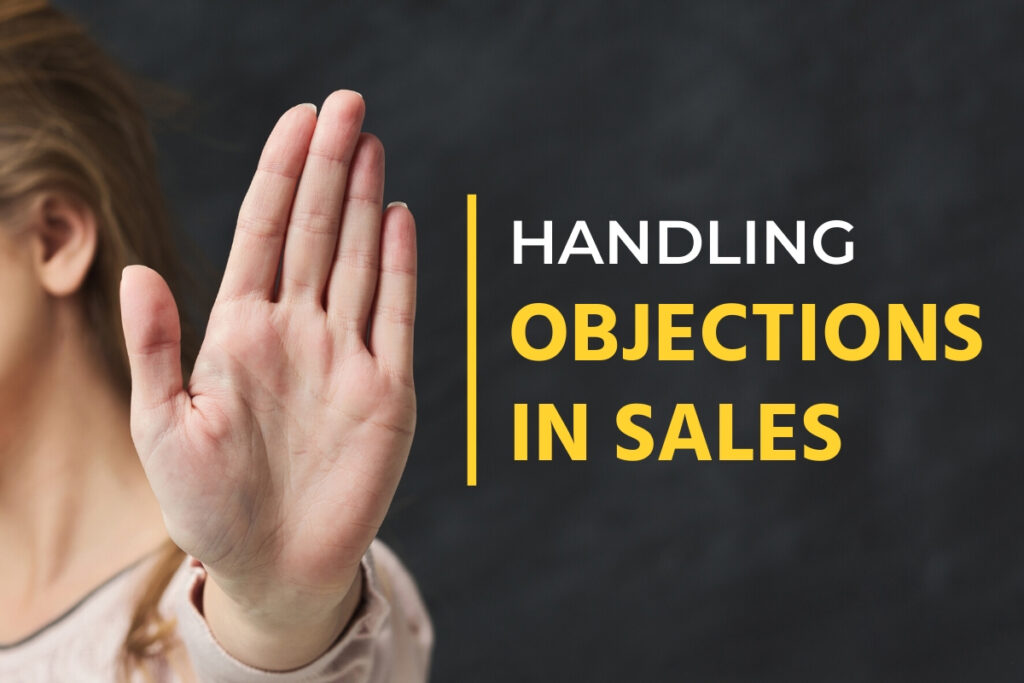Handling objections in sales calls is an important skill for any salesperson. Sales objections are a normal part of the sales process and can range from questions about the price to concerns about the product or service being offered.
However, Being told “No” may be a reality of life for salespeople, but with the right strategies, salespeople can turn objections into opportunities to build trust and credibility with customers, ultimately leading to more closed sales.
Types of objections in sales
There are primarily two types of objections in sales:
Spoken Objection
Unspoken Objection
Spoken objections are words spoken (verbal objection) by a prospect that can lead to the halt of a deal. These objections can be raised based on price, timing, quality, and decision-making.
Unspoken objections as the name implies is a nonverbal objection that can be related through gestures or facial expressions. So, it requires intelligence to identify and understand these objections to sales. Sales professionals need to look closely at the body language and posture of the prospect.
Objections are inevitable in sales, and sales reps are those who are most likely to hear them.
What are the most common objections in sales?
If a rep is handling sales objections, the following is how “no” might sound:
“Now isn’t the best time.”
“We don’t have the budget”
“I’m too busy right now.”
“Can I call you back, I’m in a meeting”
Reacting to these indirect methods of being informed “no” – these objections can only make it worse. A well-trained salesperson transforms objections and disagreement. They understand that objections to sales typically result from having opposing perspectives and not rejection.
For instance, you’re offering a great product or service that offers a high ROI. You might wonder, why would anyone ever say no to these amazing offers: they are perfect offers.
As a salesperson, the product or service you sell is the best and easiest option on the market. A consumer may be seeing your product as the same as the rest – no difference.
While it might seem as if a perfect sales rebuttal could be the solution, the core solution to sales objections is buyer enablement. In order to help buyers comprehend, they must be educated. which is the most fundamental principle to follow for how to handle objections during sales calls.
These sales strategies will help you inform your prospects and, at the same time, improve your ability to handle objections. If you’re cold calling, be sure to start with a solid sales script (if appropriate), which provides an easy path for the salesperson by incorporating these strategies into the call.
Technique for handling objections in sales
The LEAR technique is the most popular technique for handling objections in sales. LEAR stands for “Listen, Acknowledge, Explore, and Respond.”
But in this article, we’ve made these techniques easier to understand and added more tips and tricks that will help every salesperson close more deals and deal with objections.

1. Acknowledge and validate
Acknowledge the customer’s objection and validate their feelings. Use questions to understand the reasons for the customer’s objections and more. This helps to build trust and shows that you understand the customer’s concerns.
2. Buyer enablement
Based on the research conducted by SalesRuby, most buyers reject amazing offers because they do not clearly understand their problems, how to solve them, and how the solutions or the product you offer are the best fit.
What are the most effective methods to educate your buyer? Be sure to go beyond simply explaining what you think they ought to be aware of.
3. Discover the specifics; educate the prospect
Is it true that an excellent product or solution always wins? No, of course not.
This is why there are competitors even in a niche with the least audience. The most important aspect of any product is the user. There are those who want an item that can get the job done. Some are seeking extremely precise specifications or a cost-effective solution, while others are somewhere in between.
You wouldn’t invest in a supercomputer if all you needed were emails. The buyers of the supercomputer are searching for specifications. They are interested in knowing the power of the machine or the RAM. An entirely different type of consumer would opt for a laptop.
Find out what kind of detail your customer wants, and then educate your prospect about the topic. It could be a thorough research report or an easy email. If they’re interested in the most innovative aspect that your product offers, make use of the language they speak, and then provide more specifics.
4. Actively Listen
Active listening is crucial when handling objections in sales. By paying attention to what the customer is saying and responding in a way that shows you understand their concerns, you can gain a better understanding of their needs and how your product or service can meet those needs. The most frequently made error is not really listening.
If they speak, pay full attention. Don’t glance at your sales memos. Do not try to come up with an answer immediately. Don’t be distracted by things at work. Pay attention to what they’re saying.
There are two primary methods for increasing your listening abilities:
Be completely present moment. Before you make a sales call, make sure you are free of all other worries or thoughts. The lunch break is in the near future. Put it aside. Concentrate your attention on the individual in question.
Be aware of the things they’re telling you. It’s not your job to make a sale. You’re here to establish an alliance and offer value.
5. Ask clear questions.
If you’re attentive to what your prospect is saying, the next step would be to ask questions regarding an objection. Questioning helps salespeople clearly understand the buyer’s viewpoint and avoid making unfounded assumptions.
Make sure to clarify everything by absorbing as many details as they’ll offer.
Here are two ways to better ask questions.
Opt to ask open-ended questions.
Limit the number of questions you ask to one at one time.
6. Explain Your Perspective
When you have a clear understanding of a sales objection and have clarified any areas of confusion. It is now time to inform.
This is where you are able to express your reasoning and position your products, solutions, and brand. The goal is to clarify. Don’t try to convince the person you are talking to that they are incorrect. Instead, demonstrate the location where you believe the root of the dispute is. Also, you should identify the answer to the issue. And then ask if the description of the question is correct.
For instance: Prospect: “I just think this might be too expensive.”
Customer Service: “I hear that it’s expensive.” You mentioned earlier that you’re” ____,” which means it sounds like what you’re suggesting isn’t the ideal time to buy. Are you sure?”
The most important thing to say when expressing your views on the subject is to discuss what has already been said. This shows you are listening. This also shows an authentic commitment to the prospects’ journey.
7. Clarify Again
Another step in handling sales objections is to look at what the potential customer is seeking or relating the problem again. Do they really want your solution, or do they require something different? Find out more questions that clarify the issue to find out what you can do to help.
If you can spot it, the issue has turned into a discussion since there’s a shared purpose to determine what’s going on.
This is crucial because it will show how your business’ sales team views prospects. Do you see them as just a way to earn money or as opportunities to offer a great service that meets the requirements of your customers by paying attention to their concerns and needs and determining whether you can aid them?
8. Provide solutions
Once you have acknowledged the customer’s objection, it’s time to provide solutions. This is where you can demonstrate your expertise and show the customer how your product or service can meet their needs. Use specific examples and data to back up your claims.
9. Ask for the sale
After you have addressed the customer’s objections and provided solutions, it’s time to ask for the sale. Be confident and direct in your approach, and make it clear that you believe in your product or service.
10. Follow up
After the call, be sure to follow up with the customer to see if they have any further questions or concerns. This helps to build trust and keep the customer engaged in the sales process.
11. Reframe the objection
Sometimes, customers will say something that makes it hard to answer. In such cases, try to reframe the objection in a way that makes it easier to address.
11. Turn an objection into a question
Another strategy is to turn the customer’s objection into a question. This keeps the conversation going and encourages the customer to keep an open mind.
12. Demonstrate value
One of the most important things you can do to handle objections is to demonstrate the value of your product or service. Use data, testimonials, and examples to show the customer the value they will get if they choose to work with you.
13. Preparation
Be prepared for common objections by doing your research, knowing your product or service inside and out, and anticipating objections customers might have. Do your research, know your product or service inside and out, and try to guess what objections customers might have. Then familiarize yourself with possible questions, comments, and answers to explain the solutions you offer without sounding apologetic.
14. Follow up and keep in touch
Keep in touch with the customer by setting up regular calls or meetings and giving them more information or answers to their questions.
15. Personalize your approach
Personalization of responses is another tip for handling sales objections. It helps to regain the buyers’ or customers’ attention and slow the tempo. It also lets the prospect know that your answers are not generic, which shows that you have a good grasp of his or her problem.
16. Use storytelling
Another way to handle sales objections is to use storytelling. Use real-life examples and anecdotes to show the customer how your product or service has helped others.
17. Address concerns with facts and data
When handling sales objections, it’s important to use facts and data to back up your claims. This can help to build trust and credibility with customers.
18. Be flexible and adaptable
Be open to changes and adjustments when handling objections in sales calls, meetings, presentations, or demos. Sometimes, the customer might have a valid point that you weren’t aware of. Be willing to adjust your approach if necessary.
19. Stay calm and positive
Stay calm and positive when handling objections. Maintain a positive attitude and remain patient, even if the customer becomes argumentative or difficult.
Recommended article: How To Crush H1 Revenue Goals In 2023
Conclusion
Though handling objections in sales can be challenging and most times customers’ objections are because they are not empowered with the information to aid in their purchase journey. If your sales teams are struggling with handling sales objections, SalesRuby professional trainers can help you and your identify and develop responses that will reach the hearts of your prospects using our proven to be an effective strategy. Speak with a consultant.


Pingback: Sales Training: All You Need To Know About Sales Training